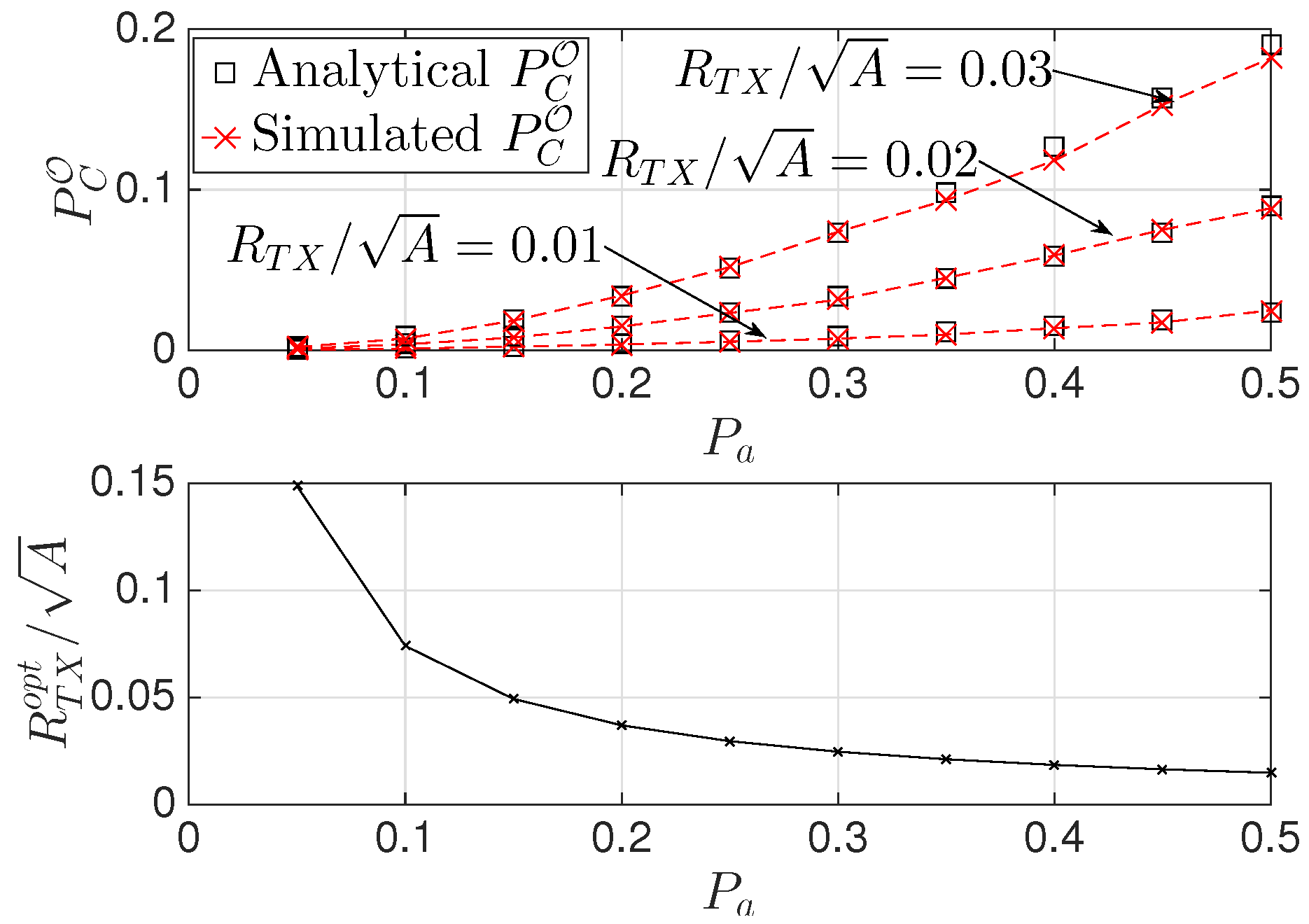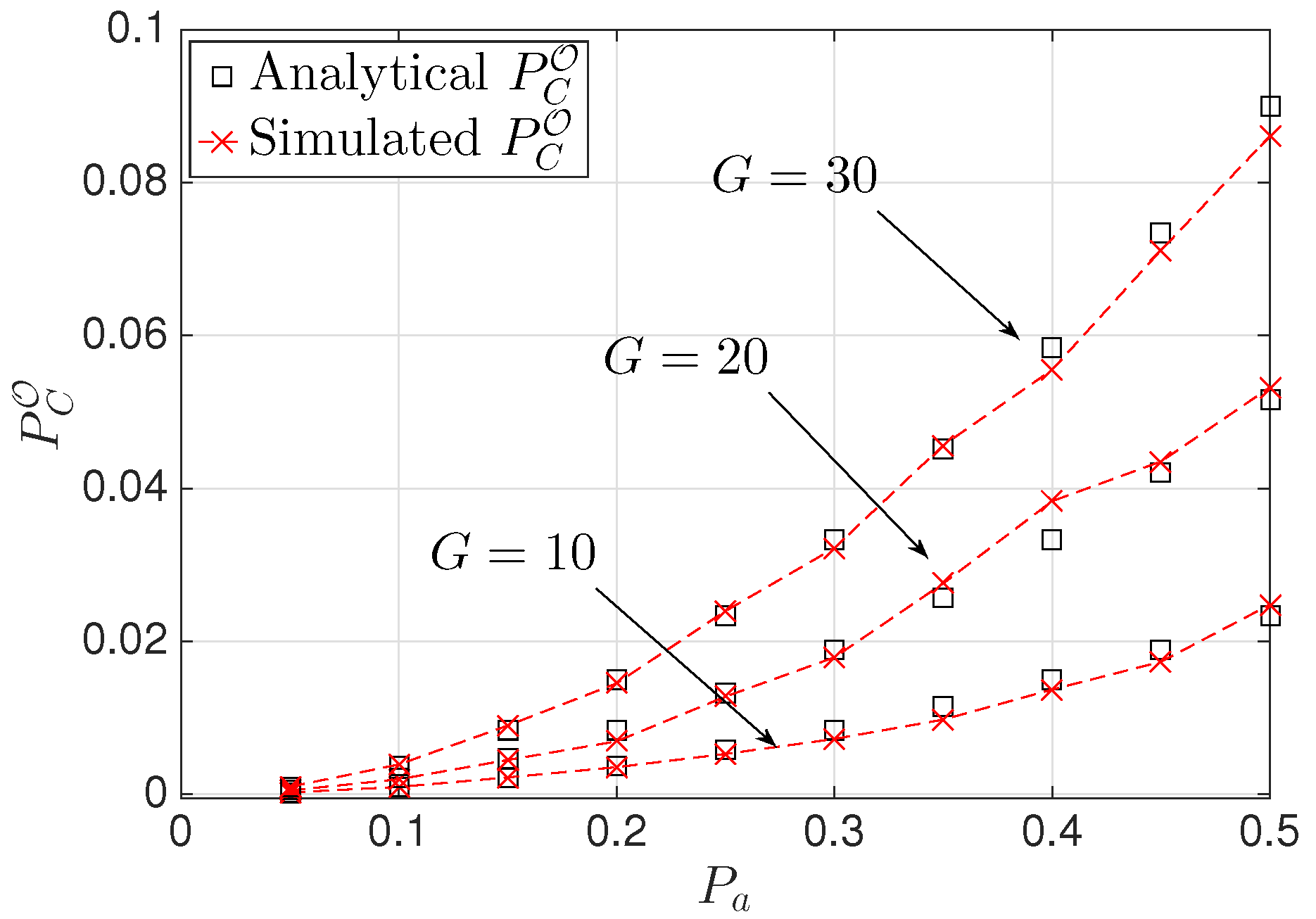On the Probabilistic Deployment of Smart Grid Networks in TV White Space
Abstract
:1. Introduction
2. System Model
3. Optimal Deployment Analysis
4. Numerical Results
5. Conclusions
Acknowledgments
Author Contributions
Conflicts of Interest
References
- Khan, A.A.; Rehmani, M.H.; Reisslein, M. Cognitive Radio for Smart Grids: Survey of Architectures, Spectrum Sensing Mechanisms, and Networking Protocols. IEEE Commun. Surv. Tutor. 2015, 18, 860–898. [Google Scholar] [CrossRef]
- Zeng, F.; Xu, J. Leasing-Based Performance Analysis in Energy Harvesting Cognitive Radio Networks. Sensors 2016, 16. [Google Scholar] [CrossRef] [PubMed]
- Zubair, S.; Syed Yusoff, S.K.; Fisal, N. Mobility-Enhanced Reliable Geographical Forwarding in Cognitive Radio Sensor Networks. Sensors 2016, 16. [Google Scholar] [CrossRef] [PubMed]
- Cacciapuoti, A.S.; Caleffi, M.; Paura, L. Widely Linear Cooperative Spectrum Sensing for Cognitive Radio Networks. In Proceedings of the 2010 IEEE Global Telecommunications Conference (GLOBECOM 2010), Miami, FL, USA, 6–10 December 2010; pp. 1–5.
- Yu, R.; Zhang, Y.; Gjessing, S.; Yuen, C.; Xie, S.; Guizani, M. Cognitive Radio based Hierarchical Communications Infrastructure for Smart Grid. IEEE Netw. 2011, 25, 6–14. [Google Scholar] [CrossRef]
- Ul Hassan, N.; Yuen, C.; Atique, M.B. Tradeoff in Delay, Cost, and Quality in Data Transmission over TV White Spaces. In Proceedings of the IEEE ICC, Kuala Lumpur, Malaysia, 23–27 May 2016.
- FCC. ET Docket 10-174: Second Memorandum Opinion and Order in the Matter of Unlicensed Operation in the TV Broadcast Bands; FCC: Washington, DC, USA, 2012.
- Caleffi, M.; Cacciapuoti, A.S. Database access strategy for TV White Space cognitive radio networks. In Proceedings of the 2014 Eleventh Annual IEEE International Conference on Sensing, Communication, and Networking Workshops (SECON Workshops), Singapore, 30 June–3 July 2014; pp. 34–38.
- Cacciapuoti, A.S.; Caleffi, M.; Paura, L. Optimal Strategy Design for Enabling the Coexistence of Heterogeneous Networks in TV White Space. IEEE Trans. Veh. Technol. 2016. [Google Scholar] [CrossRef]
- Cacciapuoti, A.S.; Caleffi, M. Interference analysis for secondary coexistence in TV white space. IEEE Commun. Lett. 2015, 19, 383–386. [Google Scholar] [CrossRef]
- Tushar, W.; Yuen, C.; Chai, B.; Huang, S.; Wood, K.L.; Kerk, S.G.; Yang, Z. Smart Grid Testbed for Demand Focused Energy Management in End User Environments. IEEE Wirel. Commun. Mag. 2016; arXiv:1603.06756. [Google Scholar]
- Kuzlu, M.; Pipattanasomporn, M.; Rahman, S. Communication network requirements for major smart grid applications in HAN, NAN and WAN. Comput. Netw. 2014, 67, 74–88. [Google Scholar] [CrossRef]
- Harrison, K.; Sahai, A. Allowing sensing as a supplement: An approach to the weakly-localized whitespace device problem. In Proceedings of the IEEE DYSPAN, McLean, VA, USA, 1–4 April 2014; pp. 113–124.
- Cacciapuoti, A.S.; Caleffi, M.; Marino, F.; Paura, L. Enabling Smart Grid via TV White Space Cognitive Radio. In Proceedings of the 2015 IEEE International Conference on Communication Workshop (ICCW), London, UK, 8–12 Jun 2015.



| Symbol | Definition |
|---|---|
| K | number of NANs deployed in the network region |
| Area of the network region | |
| The ℓ-th HAN gateway belonging to the i-th NAN | |
| The m-th HAN gateway belonging to the j-th NAN | |
| Collision probability of the transmissions of NANs i and j | |
| Overall collision probability | |
| Probability of an arbitrary HAN gateway belonging to the i-th NAN being active | |
| Probability of an arbitrary HAN gateway belonging to the i-th NAN being inactive | |
| G | Number of HAN gateways |
| Transmission range of an HAN gateway | |
| Probability of the distance between two arbitrary HAN gateways belonging | |
| to two different NANs being smaller than | |
| Collision constraint, i.e., the largest value of the overall collision probability tolerated by the SG scenario | |
| Optimal NAN coverage, i.e., the maximum value of satisfying the collision constraint | |
| The largest value of K satisfying the collision constraint |
© 2016 by the authors; licensee MDPI, Basel, Switzerland. This article is an open access article distributed under the terms and conditions of the Creative Commons Attribution (CC-BY) license (http://creativecommons.org/licenses/by/4.0/).
Share and Cite
Cacciapuoti, A.S.; Caleffi, M.; Paura, L. On the Probabilistic Deployment of Smart Grid Networks in TV White Space. Sensors 2016, 16, 671. https://doi.org/10.3390/s16050671
Cacciapuoti AS, Caleffi M, Paura L. On the Probabilistic Deployment of Smart Grid Networks in TV White Space. Sensors. 2016; 16(5):671. https://doi.org/10.3390/s16050671
Chicago/Turabian StyleCacciapuoti, Angela Sara, Marcello Caleffi, and Luigi Paura. 2016. "On the Probabilistic Deployment of Smart Grid Networks in TV White Space" Sensors 16, no. 5: 671. https://doi.org/10.3390/s16050671
APA StyleCacciapuoti, A. S., Caleffi, M., & Paura, L. (2016). On the Probabilistic Deployment of Smart Grid Networks in TV White Space. Sensors, 16(5), 671. https://doi.org/10.3390/s16050671






